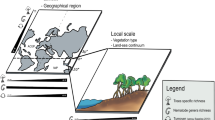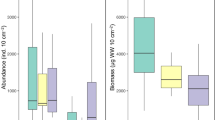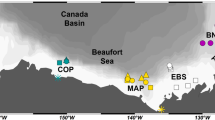Abstract
In the present study, we test whether large-scale patterns of estuarine nematodes are predicted by the “everything is everywhere” (EiE) hypothesis or by the moderate endemicity hypothesis (MEH). Specifically, we tested whether nematode genus richness and composition differ among geographical regions, latitudes, and between habitats (estuaries with and without mangroves). The meta-analysis included published data from 43 estuaries around the world. Only the most abundant genera (>1 % of relative abundance) were considered in the analysis. Each estuary was treated as an analytical unit. Results indicated that genus richness did not differ among geographical regions and between habitats, whereas latitude explained 36 % of the variability in genus richness. Genus richness assumed a bimodal pattern with higher values around the equator and in temperate regions. Canonical analysis revealed distinct nematode genus compositions in three main geographical regions and in both habitat types. These results suggest that nematodes are dispersion-limited and influenced by environmental conditions. The main conclusion is that large-scale patterns of estuarine nematodes are better predicted by the MEH, in line with studies of macroorganisms. Moreover, nematode genus turnover decreased with increasing latitude, a pattern already reported for harpacticoid copepods, land birds, vascular plants, mammals, and butterflies.





Similar content being viewed by others
References
Alongi, D. 1987. The influence of mangrove-derived tannins on intertidal meiobenthos in tropical estuaries. Oecologia 71: 537–540.
Anderson, M.J., and J. Robinson. 2003. Generalised discriminant analysis based on distances. Australian & New Zealand Journal of Statistics 45: 301–318.
Anderson, M.J., and T.J. Willis. 2003. Canonical analysis of principal coordinates: a useful method of constrained ordination for ecology. Ecology 84: 511–525.
Anderson, M.J., R.N. Gorley, and K.R. Clarke. 2008. PERMANOVA for PRIMER: guide to software and statistical methods. Plymouth, UK: PRIMER-E.
Andrew, M.E., M.A. Wulder, N.C. Coops, and G. Baillargeon. 2012. Beta-diversity gradients of butterflies along productivity gradients. Global Ecology and Biogeography 21: 352–364.
Azovsky, A.I. 2000. Concept of scale in marine ecology: linking the words or the worlds? Web Ecology 1: 28–34.
Azovsky, A.I., and Y. Mazei. 2013. Do microbes have macroecology? Large-scale patterns in the diversity and distribution of marine benthic ciliates. Global Ecology and Biogeography 22: 163–172.
Azovsky, A.I., L.A. Garlitska, and E.S. Chertoprud. 2012. Broad-scale patterns in local diversity of marine benthic harpacticoid copepods (Crustacea). Marine Ecology Progress Series 460: 63–77.
Baas-Becking, L.G.M. 1934. Geobiologie of inleiding tot de milieukunde. The Hague, The Netherlands: W.P. van Stockum and Zoon.
Bahn, V., and B.J. McGill. 2007. Can niche-based distribution models outperform spatial interpolation? Global Ecology and Biogeography 16: 733–742.
Bik, H., W.K. Thomas, D.H. Lunt, and J.P.D. Lambshead. 2010. Low endemism, continued deep-shallow interchanges, and evidence for cosmopolitan distributions in free-living marine nematodes (order Enoplida). BMC Evolutionary Biology 10: 389–399.
Boag, B., and G.W. Yeates. 1998. Soil nematodes bio- diversity in terrestrial ecosystem. Biodiversity and Conservation 7: 617–630.
Boucher, G., and P.G.D. Lambshead. 1995. Ecological biodiversity of marine nematodes in samples from temperate, tropical, and deep-sea regions. Conservation Biology 9: 1594–1604.
Chase, J.M., and J.A. Myers. 2012. Disentangling the importance of ecological niches from stochastic processes across scales. Philosophical Transactions of the Royal Society B 366: 2351–2363.
Clarke, K.R., and R.N. Gorley. 2006. PRIMER v6: user manual/tutorial. Plymouth: PRIMER-E.
Condit, R., N. Pitman, E.G. Leigh Jr., J. Chave, J. Terborgh, R.B. Foster, V.P. Nuñez, S. Aguilar, R. Valencia, G. Villa, H. Muller-Landau, E. Losos, and S.P. Hubbell. 2002. Beta-diversity in tropical forest trees. Science 295: 666–669.
Cooper, J.A.G. 2001. Geomorphology of tide-dominated and river-dominated, barred microtidal estuaries: a contrast. Journal of Coastal Research 34: 428–436.
Cooper, J.A.G. 2002. The role of extreme floods in estuary-coastal behaviour: contrasts between river- and tide-dominated microtidal estuaries. Sedimentary Geology 150: 123–157.
Cottenie, K. 2005. Integrating environmental and spatial processes in ecological community dynamics. Ecology Letters 8: 1175–1182.
Curini-Galletti, M., T. Artois, V. Delogu, W.H. De Smet, D. Fontaneto, et al. 2012. Patterns of diversity in soft-bodied meiofauna: dispersal ability and body size matter. PLoS ONE 7: e33801. doi:10.1371/journal.pone.0033801.
Derycke, S., T. Remerie, A. Vierstraete, T. Backeljau, J. Vanfleteren, M. Vincx, and T. Moens. 2005. Mitochondrial DNA variation and cryptic speciation within the free-living marine nematode Pellioditis marina. Marine Ecology Progress Series 300: 91–103.
Derycke, S., G. Fonseca, A. Vierstraete, J. Vanfleteren, M. Vincx, and T. Moens. 2008. Disentangling taxonomy within the Rhabditis (Pellioditis) marina (Nematoda, Rhabditidae) species complex using molecular and morphological tools. Zoological Journal of the Linnean Society 152: 1–15.
Elliot, M., and D.S. Mclusky. 2002. The need definitions in understanding estuaries. Estuarine Coastal and Shelf Science 55: 815–827.
Ellisson, A.M. 2002. Macroecology of mangroves: large scales patterns and processes in tropical coastal forests. Trees-Structure and Function 16: 181–194.
Fenchel, T., and B.J. Finlay. 2004. The ubiquity of small species: patterns of local and global diversity. Bioscience 54: 777–784.
Fenchel, T., and B.J. Finlay. 2006. The diversity of microbes: resurgence of the phenotype. Philosophical Transactions of the Royal Society B 361: 1965–1973.
Ferrero, T.J., N.J. Debenham, and P.J.D. Lambshead. 2008. The nematodes of the Thames estuary: assemblage structure and biodiversity with a test of Atrill´s linear model. Estuarine Coastal and Shelf Science 79: 409–418.
Finlay, B.J., and K.J. Clarke. 1999. Ubiquitous dispersal of microbial species. Nature 400: 828.
Foissner, W. 2006. Biogeography and dispersal of microorganisms: a review emphasizing protists. Acta Protozoologica 45: 111–136.
Foissner, W. 2008. Protist diversity and distribution: some basic considerations. Biodiversity and Conservation 17: 235–242.
Foissner, W., A. Chao, and L.A. Katz. 2008. Diversity and geographic distribution of ciliates (Protista: Ciliophora). Biodiversity and Conservation 17: 345–363.
Fonseca, G., and T. Soltwedel. 2009. Regional patterns of nematode assemblages in the Arctic deep seas. Polar Biology 32: 1345–1357.
Fonseca, G., T. Moens, and S. Derycke. 2008. Integrative taxonomy in two free-living nematode species complexes. Biologica Journal of the Linnean Society 94: 737–753.
Fonseca, G., T. Soltwedel, A. Vanreusel, and M. Lindegarth. 2010. Variation in nematode assemblages over multiple spatial scales and environmental conditions in Arctic deep seas. Progress in Oceanography 84: 174–184.
Fonseca, G., P. Hutchings, and F. Gallucci. 2011. Meiobenthic communities of seagrass beds (Zostera capricorni) and unvegetated sediments along the coast of New South Wales, Australia. Estuarine, Coastal and Shelf Science 91: 69−77.
Fontaneto, D. 2006. Biogeography of microscopic organisms, is everything small everywhere. Cambridge: Cambridge University Press.
Fontaneto, D., G.F. Ficetola, R. Ambrosini, and C. Ricci. 2006. Patterns of diversity in microscopic animals: comparable to protists or to larger animals? Global Ecology and Biogeography 15: 153–162.
Fontaneto, D., T.G. Barraclough, K. Chen, C. Ricci, and E.A. Herniou. 2008. Molecular evidence for broad-scale distributions in bdelloid rotifers: everything is not everywhere but most things are very widespread. Molecular Ecology 17: 3136–3146.
Gaston, K.J., R.G. Davies, C.D.L. Orme, V.A. Olson, G.H. Thomas, T.S. Ding, P.C. Rasmussen, J.J. Lennon, P.M. Bennett, I.P.F. Owens, and T.M. Blackburn. 2007. Spatial turnover in the global avifauna. Proceedings of the Royal Society B 274: 1567–1574.
Hawkins, B.A., R. Field, H.V. Cornell, D.J. Currie, et al. 2003. Energy, water, and broad-scale geographic patterns of species richness. Ecology 84: 3105–3117.
Heip, C., M. Vincx, and G. Vranken. 1985. The ecology of marine nematodes. Oceanography and Marine Biology: an Annual Review 23: 399–489.
Hewitt, J.E. 1998. The effect of changing sampling scales on our ability to detect effects of large-scale processes on communities. Journal of the Experimental Marine Biology and Ecology 227: 251–264.
Hillebrand, H. 2004a. On the generality of the latitudinal gradient. American Naturalist 163: 192–211.
Hillebrand, H. 2004b. Strength, slope and variability of marine latitudinal gradients. Marine Ecology Progress Series 273: 251–267.
Hillebrand, H., and A.L. Azovsky. 2001. Body size determines the strength of the latitudinal diversity gradient. Ecography 24: 251–256.
Hodda, M. 2007. Phylum Nematoda. Zootaxa 1668: 265–293.
Hutchings, P. 1999. Taxonomy of estuarine invertebrates in Australia. Australian Journal of Ecology 24: 381–394.
Kirwan, M.L., G.R. Guntenspergen, and J.T. Morris. 2009. Latitudinal trends in Spartina alterniflora productivity and the response of coastal marshes to global change. Global Change Biology 15: 1982–1989.
Koleff, P., J.J. Lennon, and K.J. Gaston. 2003. Are there latitudinal gradients in species turnover? Global Ecology and Biogeography 12: 483–498.
Lambshead, P.J.D., J. Tietjen, T. Ferrero, and P. Jensen. 2000. Latitudinal diversity gradients in the deep sea with special reference to North Atlantic nematodes. Marine Ecology Progress Series 194: 159–167.
Lambshead, P.J.D., C.J. Brown, T.J. Ferrero, N.J. Mitchell, C.R. Smith, L.E. Hawkins, and J. Tietjen. 2002. Latitudinal diversity patterns of deep-sea marine nematodes and organic fluxes: a test from the central equatorial Pacific. Marine Ecology Progress Series 236: 129–135.
Legendre, P. 1993. Spatial autocorrelation: trouble or new paradigm? Ecology 74: 1659–1673.
Logue, J.B., N. Mouquet, H. Peter, and H. Hillebrand. 2011. Empirical approaches to metacommunities: a review and comparison with theory. Trends in Ecology & Evolution 26: 482–491.
McIntyre, H.L., and J.J. Cullen. 1996. Primary production by suspended and benthic microalgae in a turbid estuary: time scale variability in Santo Antonio Bay, Texas. Marine Ecology Progress Series 145: 245–268.
Midgley, G.F., J. Bond, V. Kapos, C. Ravilious, J.P.W. Scharlemann, and F.I. Woodward. 2010. Terrestrial carbon stocks and biodiversity: key knowledge gaps and some policy implications. Current Opinion in Environmental Sustainability 2: 264–270.
Moens, T., and M. Vincx. 1997. Observations on the feeding ecology of estuarine nematodes. Journal of the Marine Biological Association of the United Kingdom 77: 211–227.
Nanajkar, M., and B. Ingole. 2010. Comparison of tropical nematode communities from the three harbors, west coast of India. Cahiers de Biologie Marine 51: 9–18.
Odum, W.E. 1988. Comparative ecology of tidal freshwater and salt marshes. The Annual Review of Ecology, Evolution, and Systematics 19: 147–176.
Peterson, C., K. Scheidegger, P. Komar, and W. Niem. 1984. Sediment composition and hydrography in six high-gradient estuaries of the northwestern United States. Journal of Sedimentary Research 54: 86–97.
Procter, D.L.C. 1984. Towards a biogeography of free-living soil nematodes. I. Changing species richness, diversity and densities with changing latitude. Journal of Biogeography 11: 103–117.
Qian, H., and R.E. Ricklefs. 2007. A latitudinal gradient in large-scale beta diversity for vascular plants in North America. Ecological Letters 10: 737–744.
Qian, H., C.F. Badgley, and L. David. 2009. The latitudinal gradient of beta diversity in relation to climate and topography for mammals in North America. Global Ecology and Biogeography 18: 111–122.
Sebastian, S., M. Raes, I. De Mesel, and A. Vanreusel. 2007. Comparison of the nematode fauna from the Weddell Sea Abyssal plain with two North Atlantic abyssal sites. Deep-Sea Research Part II 54: 1727–1736.
Smith, C.R., W. Berelson, D.J. Demaster, F.C. Dobbs, D. Hammond, D.J. Hoover, R.H. Pope, and M. Stephens. 1997. Latitudinal variations in benthic processes in the abyssal equatorial Pacific: control by biogenic particle flux. Deep-Sea Research Part II 44: 2295–2317.
Vanreusel, A., G. Fonseca, R. Danovaro, et al. 2010. The contribution of deep-sea macrohabitat heterogeneity to global nematode diversity. Marine Ecology 31: 6–20.
Acknowledgment
We thank the critical reading of Fabiane Gallucci and Jon Norenburg, as well as three anonymous reviewers. We thank Ruth Gingold (sweepandmore.com) for the critical reading and editing of the manuscript. GF is supported by FAPESP (2009/14019-0) and SN by CNPq (306740/2012-5).
Author information
Authors and Affiliations
Corresponding author
Additional information
Communicated by Alf Norkko
Electronic supplementary material
Below is the link to the electronic supplementary material.
ESM Table 1
(DOC 115 kb)
Rights and permissions
About this article
Cite this article
Fonseca, G., Netto, S.A. Macroecological Patterns of Estuarine Nematodes. Estuaries and Coasts 38, 612–619 (2015). https://doi.org/10.1007/s12237-014-9844-z
Received:
Revised:
Accepted:
Published:
Issue Date:
DOI: https://doi.org/10.1007/s12237-014-9844-z




